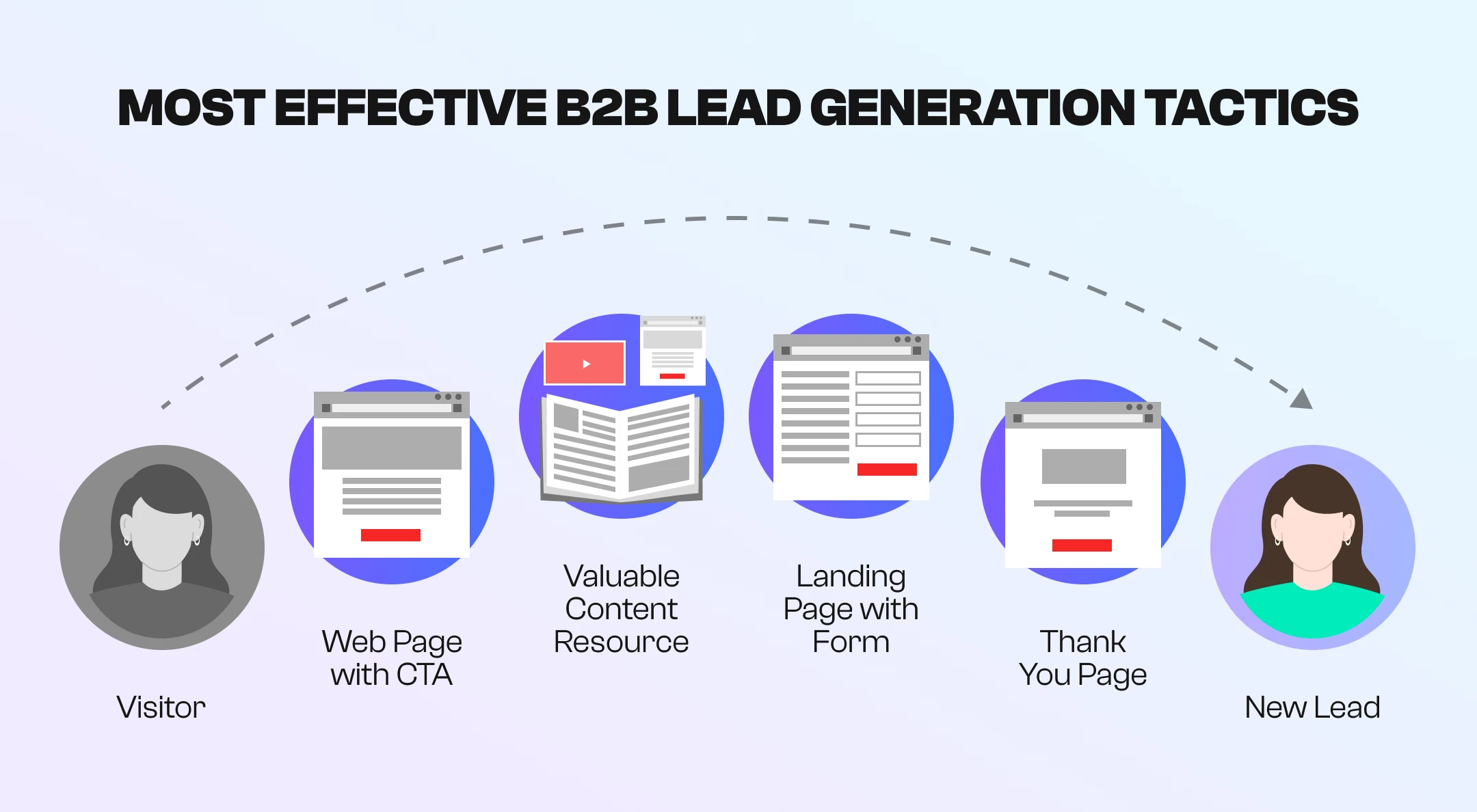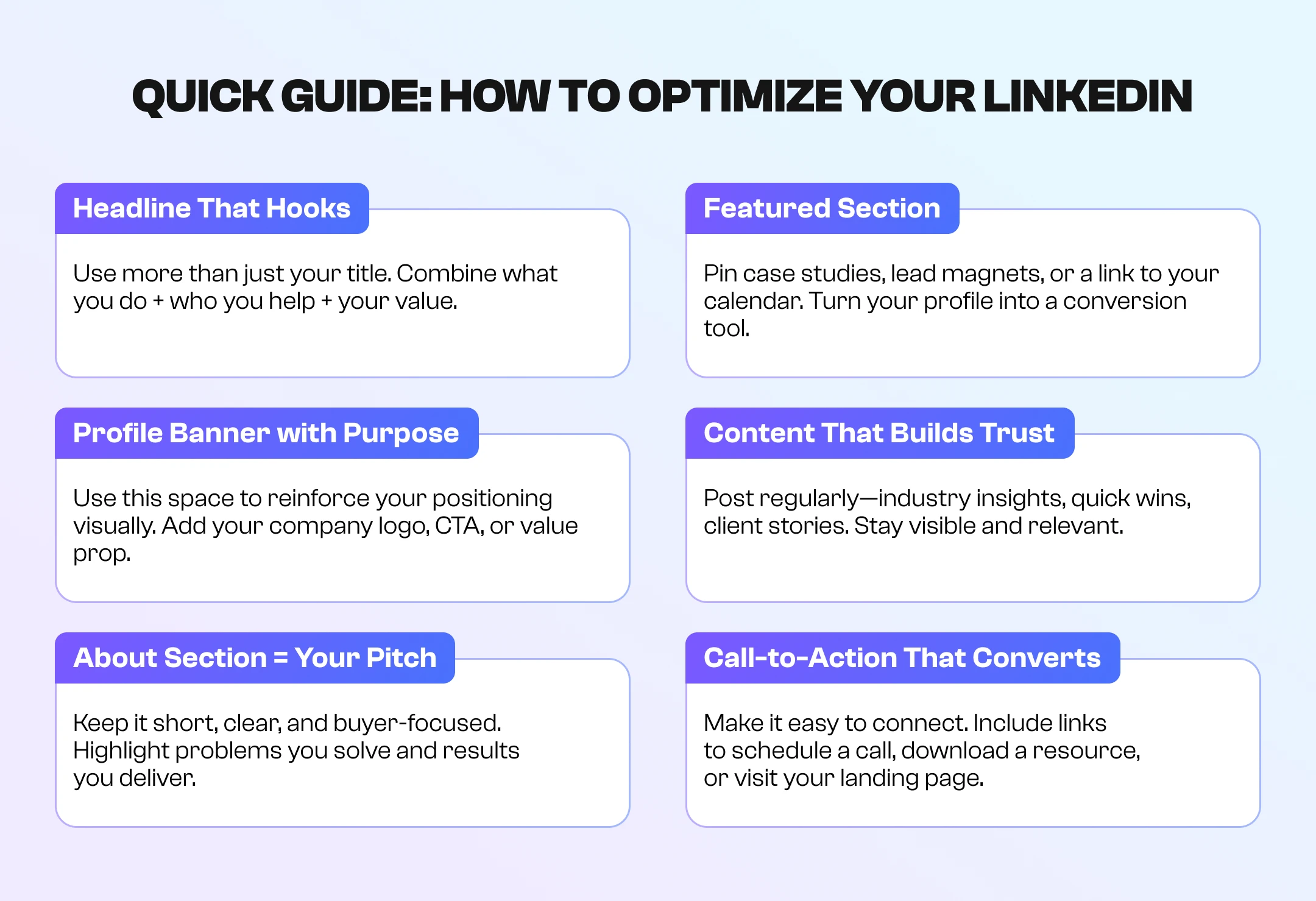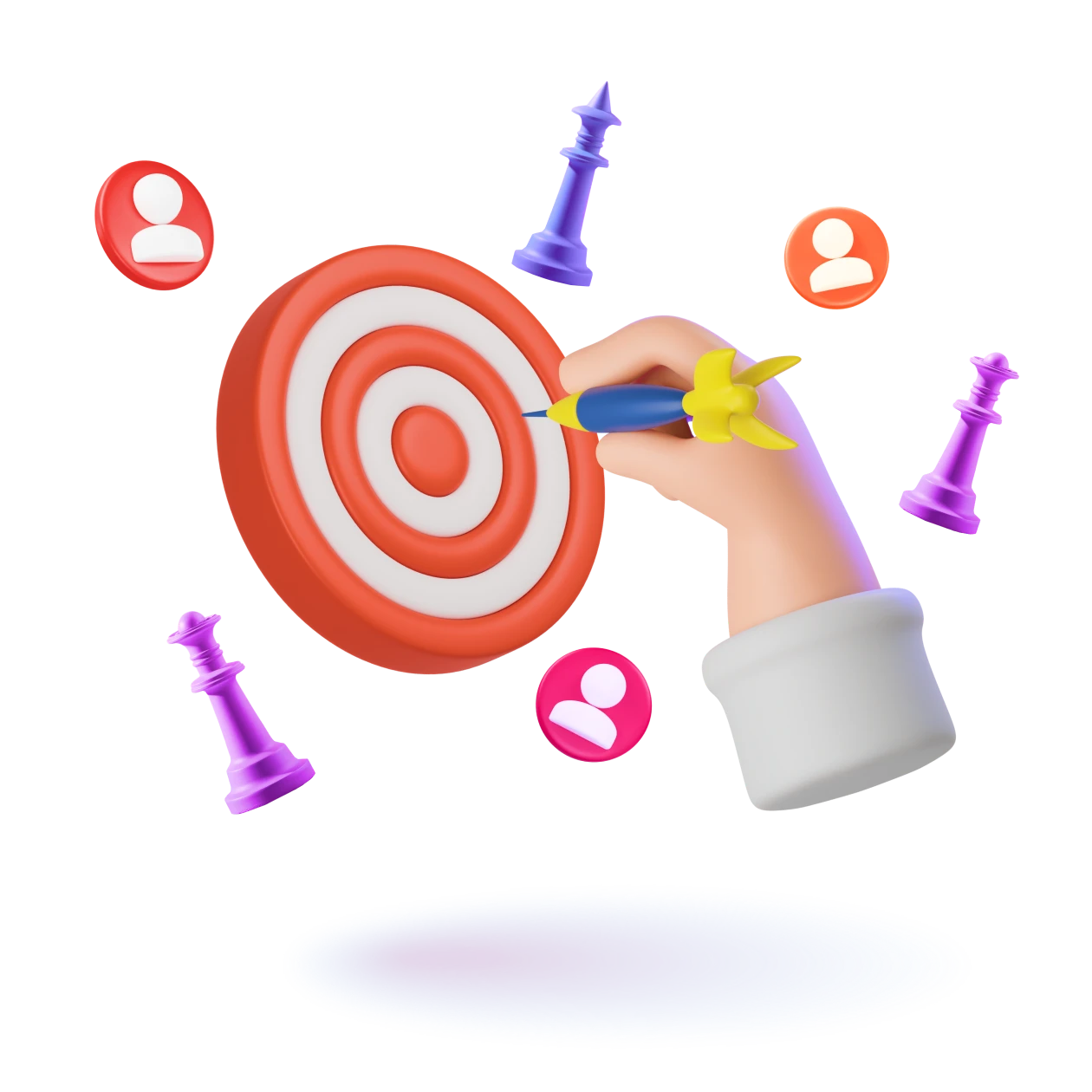I still remember our early days at SalesAR. A client contacted us with over 10,000 monthly website visitors, including organic, paid, and referral traffic. But they were scratching their heads over one painful fact: fewer than 20 leads a month. That’s when it hit us (and them): traffic alone is just noise. Without the right systems in place to turn attention into action, you’re simply wasting money.
So, no fluff here. This article summarizes the most effective B2B lead generation tactics we have tested and proven across various campaigns. These aren’t guesses—we’ve run, optimized, and scaled these tactics across multiple campaigns. Let’s get into it.
- The Groundwork: Know Who You’re Chasing
- Turn Visitors into Leads: Your Website as a Sales Machine
- Give to Get: Content That Pulls the Right Leads
- Go Straight to the Source: ABM & Outreach
- Don’t Let Them Go: Retargeting Done Right
- Prioritize Your Time: Lead Scoring & Feedback
- Partnership & Co-Marketing Campaigns
- The Tech That Makes It Possible
- Conclusion
The Groundwork: Know Who You’re Chasing
One of our most revealing wins came from a cybersecurity client. They came to us targeting CTOs across mid-sized firms. Smart, right? Turns out, it wasn’t. When we dug into closed-won data and did our homework, we realized their actual buyers weren’t tech leaders—they were heads of compliance. That one shift? It boosted their lead qualification rate by 37%.
This story is a reminder that even the best B2B lead generation tactics can fall flat if your ICP is off. Yes, firmographics like company size, industry, and geography matter. But that’s just the surface. You must go deeper—understand who makes the call, what keeps them up at night, how long their buying cycle is, and who influences the final decision. Even the best lead generation tactics will hit the mark without that clarity, no matter how proven.
SiriusDecisions says 68% of B2B marketers report improved performance after refining their ICP. This is not surprising. Even if you send the wrong message to the wrong person, you’ll still lose.
Turn Visitors into Leads: Your Website as a Sales Machine
One of the simplest changes we ever made had one of the biggest payoffs. We created a multi-step pop-up laser-focused on CFOs for a financial SaaS client, offering a lead magnet designed for them. It wasn’t flashy. It wasn’t annoying. It just worked. Conversion rates jumped from 1.4% to 4.9%.
That kind of lift doesn’t happen by accident. It happens when you stop treating your site like a brochure and use it like a sales machine. This is the power of clever lead generation marketing tactics: targeted, relevant, and built around what your buyer cares about.
Let’s break down how to do that.
Smart Popups and Exit-Intent Offers
Popups aren’t dead—they’re just misunderstood. The trick is knowing when and to whom to show them. A user scrolling 75% down the page? They’re engaged. Someone moving their mouse toward the “X” in the corner? Hit them with an exit-intent offer. Someone idle for 20 seconds? Wake them up with a free audit.
And the numbers back it up: personalized popups convert 42% better than generic ones.
If your CTA is just “Contact us,” you’ve already lost. Give value upfront. Free calculator, ROI checklist, short audit? That’s what starts the conversation.
Website Personalization
Not everyone should see the same thing when they land on your site. We treat cold email traffic and organic search traffic differently. Why? Because intent matters.
Cold traffic needs clarity fast. What’s the offer? Why should they care? Organic traffic might be warmer—they’ve seen your name before, maybe read a blog. They’re ready for more detail.
This type of personalized content is one of the best lead generation tactics when paired with segmented targeting and behavioral insights. A CMO shouldn’t see the same case study as an IT director. Simple changes like this make your page feel like it was designed for the person reading it, and they are more likely to convert.

AI Chatbots and Multi-Step Forms
Here’s the truth: forms still work. But not when they feel like job applications.
Multi-step forms that ease in with simple questions like “What’s your role?” build momentum. Once someone clicks, they are more likely to complete the task. Plus, you get better data. That means better routing, faster follow-up, and less lead waste.
And AI chatbots? They’re no longer just clunky scripts. With tools like Drift, you can build flows that feel human, routing leads to the right representative and qualifying them in real-time.
In short, talk to visitors like people. Make it easy to say yes. The most effective lead generation tactics aren’t flashy—they’re empathetic, frictionless, and built around real behavior. That’s how websites stop being digital billboards and become true lead engines.
Give to Get: Content That Pulls the Right Leads
We once helped a MarTech firm struggling to generate leads from its content marketing efforts. They had an eBook titled “Trends in Marketing Technology: An Industry Overview.” It was well-designed, well-researched, and flatlined. So, we changed the positioning. Same insights, new title: “Your 2024 MarTech Planning Toolkit.” Suddenly, it wasn’t an abstract read—it was a resource. In two months, it generated over 300 marketing-qualified leads.
That’s the difference between content that talks and content that works. Strategic lead generation marketing tactics don’t just boost visibility—they turn passive assets into active funnels, pulling in the right people at the right time.
High-Intent Lead Magnets
Templates. ROI calculators. Priority checklists. Exclusive benchmarks. These are among the top lead generation tactics B2B marketers rely on to win high-intent prospects. They’re quick to use, role-specific, and immediately valuable.
79% of marketers say lead magnets are their top lead generation tactic. Not surprising when you consider how much easier it is to win attention with something practical versus another 12-page whitepaper collecting dust in a downloads folder.
Here’s our rule: if the lead magnet doesn’t solve a problem in under 5 minutes, it’s not ready—value first, branding second.
At SalesAR, we often say that no tactic can fix a fuzzy target. Want better leads? Start by clarifying who you’re after. Even the best lead generation tactics won’t work if you target the wrong audience.
Gated vs. Ungated
Not every piece of content should ask for an email address. Gating awareness-stage content, such as blog posts or introductory videos, can backfire. It slows down trust-building and often cuts off the top of your funnel.
Instead, gate mid- to bottom-funnel assets—some of the most effective lead generation tactics, like planning guides, budget tools, and role-specific audits. These are the offers for which people are more willing to exchange their contact information, because the payoff is clearer.
Build goodwill first. Then ask for something in return.
Go Straight to the Source: ABM & Outreach
We ran a campaign for a high-ticket B2B SaaS company, taking personalization to the next level. We built a dedicated landing page for each target account, complete with their logo, pain-point-specific copy, and a message from their assigned Sales Development Representative (SDR). It wasn’t overly complex—just thoughtful. The result? A 17% reply rate and multiple six-figure deals in the pipeline within weeks.
That’s the power of going straight to the source. No, hoping they stumble across your blog. No waiting for “brand awareness” to kick in. Just innovative, direct outreach backed by strategy.
When paired with high-quality landing pages, personalized outreach remains one of the best B2B lead generation tactics for connecting directly with decision-makers.
Account-Based Marketing in Action
Account-Based Marketing (ABM) isn’t about blasting messages to a list but crafting a real conversation. We typically run “one-to-few” campaigns, where each prospect group receives tailored messaging, creative assets, and often their mini landing page.
And it’s not just email. LinkedIn matters here, especially when it’s integrated into the flow. Connect, follow, and engage with the content, then follow up with a personalized email. When done right, these touchpoints stack. They create familiarity, which leads to trust, and ultimately, opportunity.
ABM remains one of the strongest lead generation tactics B2B companies can use, especially when sales and marketing align behind shared goals.
LinkedIn Profile Optimization
Think your prospects aren’t looking you up? They are.
82% of buyers check out sellers on LinkedIn before replying. And if your profile looks like a resume from 2013, that trust you just built? Gone.
Here’s what we tell every SDR we train: your profile should feel like a landing page, not a job history. It should have a clear headline, a short “About” that explains who you help and how, a banner image that fits your pitch, and a CTA that leads somewhere.
Add a few posts showing you understand your industry—and suddenly, you’re not another stranger. You’re a resource.
Quick Guide: How to Optimize Your LinkedIn Profile for Lead Generation
1. Headline That Hooks
Your headline is prime real estate. Skip the job title and use it to quickly explain what you do, who you help, and the results you bring. A strong headline communicates value and makes you instantly relevant to your ideal prospect.
Example: “Helping B2B SaaS Teams Generate 50% More Qualified Leads Through Targeted Outreach”
Think of it as your elevator pitch in a single line.
2. Profile Banner with Purpose
Your banner image is a visitor’s first visual cue—don’t leave it blank or generic. Use this space to reinforce your personal or company brand. Consider including:
- A short value proposition or tagline
- Your company’s logo
- A visual cue, like a CTA or calendar link.
- A clean, branded image makes you look credible at first glance. Canva or Figma can help you create one without a designer.
3. About Section = Your Pitch
This isn’t the place for a career memoir. Instead, speak directly to your ideal client. Describe who you help, what problems you solve, and the kind of results you deliver. Use clear, direct language that highlights your unique value. Structure it like this:
- Who you help: Be specific about your audience (e.g., “B2B SaaS teams,” “mid-market fintech companies”).
- What you solve: Identify key pain points or inefficiencies.
- What results you deliver: Mention outcomes like “boosting lead conversion” or “reducing sales cycle length.”
- CTA: End with a clear next step, such as “Let’s talk” or “Book a free consultation.”
Think of this section as your positioning pitch—focused, client-facing, and action-oriented.
4. Featured Section
The Featured section enables you to showcase content that enhances your credibility and advances prospects. Yet, many profiles leave it empty or underutilized. Use it to highlight high-value content like:
- Case studies or testimonials
- Lead magnets (e.g., checklists, eBooks)
- Thought leadership pieces or webinars
- A direct calendar link for discovery calls
Pin your best-performing asset at the top. The goal is to make it easy for visitors to understand your value and take the next step.
5. Content That Builds Trust
You don’t need to post daily, but consistency matters. Share insights, customer stories, quick lessons, or even mistakes and how you fixed them. Focus on content that educates or solves real problems. This builds authority without sounding salesy.
You can post:
- Short lessons from real client work
- Industry trends and your take on them
- Practical tips or frameworks
- Success stories that reflect your impact
Over time, this builds familiarity, credibility, and trust, long before the first call.
6. Call-to-Action That Converts
Your contact section should work just as hard as the rest of your profile. Make it easy for prospects to take action by adding:
- Your email address
- A Calendly or booking link
- A lead magnet or landing page
Also, reinforce that CTA in your About and Featured sections so it’s always visible—don’t make visitors hunt for it. When used strategically, repetition can increase conversions.

Don’t Let Them Go: Retargeting Done Right
We once worked with a B2B logistics platform with solid traffic, but too many pricing pages bounced without a trace. We set up a simple retargeting campaign targeting only visitors who had already visited our site. The ads weren’t fancy—just sharp messaging and a clear call to action. 28 MQLs came in within the first month—no new content, redesign, or smart retargeting.
Most B2B buyers don’t convert on the first touch. Or the second. That’s why retargeting exists—not to chase, but to stay top-of-mind until they’re ready.
Focusing on the best B2B lead generation tactics means doubling down on what drives results: targeting, personalization, and consistently delivering value.
Multi-Channel Retargeting
Retargeting only works if your audience sees you again. And that’s where multi-channel makes all the difference. Google Display for broad reach. LinkedIn for precision and credibility. Meta (yes, even for B2B) for low-cost impressions.
The trick is to match your message to where they are in the funnel. Someone who reads a blog post should see a case study. Someone who hits your pricing page should see a comparison guide or a quick demo CTA.
Consistency across platforms builds familiarity. And familiarity builds trust.
Email & Content Nurturing
Most B2B lead generation efforts end too early. Someone downloads your toolkit or hits reply, and that’s the last they hear from you—big mistake.
Our best nurturing sequences consist of 5 to 7 emails, each focused on solving a problem, sharing a resource, or telling a quick success story. There is no heavy sell—just value, spaced out with intent.
Mix in re-engagement content—product updates, webinars, customer stories—and other proven lead generation marketing tactics to keep your brand top-of-mind.
Prioritize Your Time: Lead Scoring & Feedback
There’s nothing worse than a packed sales calendar full of the wrong calls. We had a health tech SaaS client facing exactly that—too many demo requests, but most were going nowhere. We implemented a behavioral lead scoring model, which weighs factors such as email opens, content views, and time spent on pricing pages. Within weeks, they booked 40% fewer unqualified demos, and their close rates climbed.
Because the truth is, it’s not about more leads. It’s about better ones.
Build a Lead Scoring System
Not all leads require the same level of attention. Some are just poking around. Others are shopping and fast.
Lead scoring helps you sort them out. Combine engagement data (downloads, clicks, return visits) with fit (job title, industry, company size) and recency (how long ago they acted). This gives you a clear picture of who’s hot and who’s not.
Then plug it into your CRM. Let automation handle the sorting so your sales team can focus on closing, not guessing.
Learn from No-Shows
Even the best campaigns have drop-offs, demo no-shows, abandoned forms, and dead replies. Most people ignore that data. We don’t.
Run exit surveys. Use heatmaps to see where users lose interest—track form abandonment rates. Often, the issue isn’t the product—it’s how you presented it.
If your leads aren’t responding, don’t rush to blame your email list or sender identity. Start by refining your messaging.
Partnership & Co-Marketing Campaigns
One of the most efficient ways we’ve seen companies generate high-quality leads, without reinventing the wheel, is through smart partnerships. Let me give you a real example.
We had two SaaS clients: one focused on marketing automation and the other on CRM optimization. They had the same buyer persona but different pain points. We connected them, helped them co-host a practical webinar called “Double Your Conversion Rate Without Doubling Your Budget,” and followed it up with a co-branded eBook. No paid traffic. No cold outreach. Just shared value. Within six weeks, both companies saw a 2x increase in qualified leads, and they continued to close their pipeline for months afterward.
That’s the magic of co-marketing lead generation tactics B2B: you’re not selling to strangers—you’re showing up with a friend who’s already earned trust with your audience.
The formats can vary.
- Joint webinars where both brands share their take on a common problem.
- Co-branded reports or industry insights that bring in thought leadership from multiple angles.
- Partner landing pages with bundled offers or mutual CTAs.
- Even simple guest blog swaps fall into the category of top lead generation tactics when paired with mutual CTAs and niche alignment.
However, it only works if the partnership is aligned. Think: shared ICP, complementary services, and a mutual understanding of lead handoff or attribution. You want your partner to win as much as you do.
Don’t treat co-marketing like a complete merger. Start with a small, clear campaign—a short webinar, a mini guide, or a joint LinkedIn Live. If it clicks? Scale from there. If not? You haven’t overcommitted.
Co-marketing is one of the most underutilized yet incredibly effective lead generation tactics, especially for niche B2B audiences seeking trusted entry points.
The Tech That Makes It Possible
Most effective B2B lead generation tactics are only half the story—tools make them scalable. But here’s the catch: most teams use too many. We’ve seen companies drown in their tech stack, running five platforms that barely talk to each other. When we streamline that to a focused set of essentials, execution gets faster and results come quicker.
So, what tools truly deliver value? Here’s what we lean on again and again.
- Popups: OptiMonk and Sleeknote offer easy-to-use behavior-based triggers, dynamic content, and A/B testing. These are perfect for lead magnets and exit-intent offers without needing a developer on speed dial.
- CRM & Email: HubSpot is an all-in-one machine for marketing and sales alignment, while Apollo is a go-to for outbound outreach and enriched data. Together, they give you visibility and control.
- Chat: Drift is significant for high-touch, sales-driven convos. Tidio offers fast, affordable automation with solid routing and bot flows. Both increase engagement and reduce bounce.
Don’t overtool. Select three to four core tools, ensure they integrate seamlessly, and build your playbook around them. A small, synced stack beats a bloated, disconnected one every time.
Conclusion
Our most successful clients don’t have the most significant budgets or the longest email lists. They focus on the most effective lead generation tactics and questions.
Who cares more about fit than volume? Who asks the right questions? Most importantly, they treat every lead like a relationship worth earning.
They personalize. They test and adjust. They commit to the best B2B lead generation tactics that align with their ICP and funnel stage.
Because at the end of the day, you’re not just generating leads—you’re building trust, one touchpoint at a time. That’s what drives real results. That’s what scales.
If you’re serious about improving your pipeline, we’re here to help.
No cold outreach, no stress. Just sales-ready calls with decision-makers.


